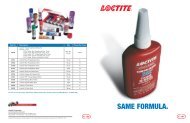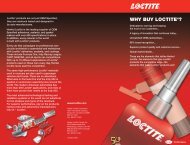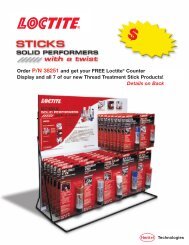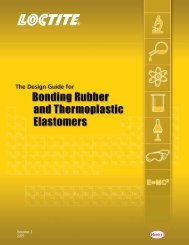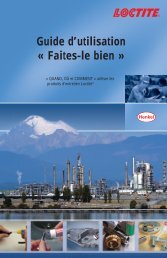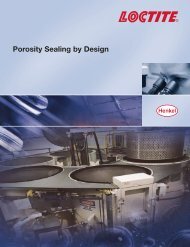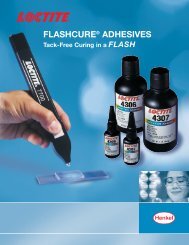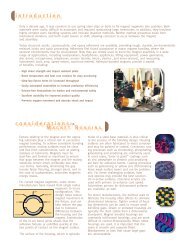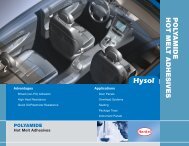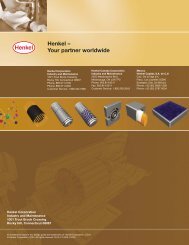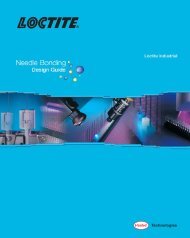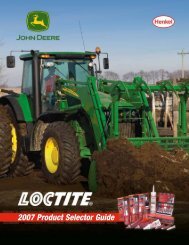Volume 4 - Loctite.ph
Volume 4 - Loctite.ph
Volume 4 - Loctite.ph
Create successful ePaper yourself
Turn your PDF publications into a flip-book with our unique Google optimized e-Paper software.
Test MethodsSubstrate Preparation1. Substrates were cut into 1" x 1" x 0.125" block sheartest specimens.2. All bonding surfaces were cleaned with isopropyl alcohol.Surface Roughness1. The test specimens were manually abradedusing a 3M Heavy-Duty Stripping Pad.2. The surface roughness was determined using a Surfanalyzer4000 with a traverse distance of 0.03 in. and a traverse speedof 0.01 in. per second.Adhesive Application and Cure MethodCYANOACRYLATES(<strong>Loctite</strong> ® 380 Black Max ® , 401 Prism ® ,4011 Prism ® and 414 Super Bonder ® Instant Adhesives)1. Adhesive was applied in an even film to one test specimen.2. A second test specimen was mated to the first witha 0.5" overlap (bond area = 0.5 in. 2 ).3. The block shear assembly was clamped with two Brink andCotton No. 1 clamps.4. The bonded assembly was allowed to cure at ambient conditionsfor 1 week before testing.CYANOACRYLATES WITH POLYOLEFIN PRIMERS(<strong>Loctite</strong> ® 401 Prism ® Instant Adhesive and<strong>Loctite</strong> ® 770 Prism ® Primer)1. Polyolefin primer was brushed onto each bonding surface.2. The polyolefin primer’s carrier solvent was allowed to flash off.3. Adhesive was applied in an even film to one substrate.4. The second test specimen was mated to the first witha 0.5" overlap (bond area = 0.5 in. 2 ).5. The block shear assembly was clamped with two Brink andCotton No. 1 clamps.6. The bonded assembly was allowed to cure at ambient conditionsfor 1 week before testing.TWO-PART, NO-MIX ACRYLIC(<strong>Loctite</strong> ® 330 Depend ® Adhesive)1. <strong>Loctite</strong> ® 7387 Depend ® Activator was sprayedon one test specimen.2. The activator’s carrier solvent was allowed to flash off formore than two minutes.3. <strong>Loctite</strong> ® 330 Depend ® Adhesive was applied in an evenfilm to a second test specimen.4. Within 30 minutes, the second test specimen was mated tothe first with a 0.5" overlap (bond area = 0.5 in. 2 ).5. The block shear assembly was clamped with two Brink andCotton No. 1 clamps.6. The bonded assembly was allowed to cure at ambientconditions for one week before testing.LIGHT CURE ADHESIVES(<strong>Loctite</strong> ® 3105 and 3340 Light Cure Adhesives and<strong>Loctite</strong> ® 4305 Flashcure ® Light Cure Adhesives)1. Adhesive was applied in an even film to one test specimen.2. A UV transparent, medical polycarbonate 1" x 1" x 0.125" testspecimen was cleaned with isopropyl alcohol.3. The second test specimen was mated to the firstwith a 0.5" overlap (bond area = 0.5 in. 2 ).4. The block shear assembly was irradiated (through thepolycarbonate) by an ultraviolet light source for 30 seconds tocure the adhesive. The ultraviolet light source used was a FusionUV Curing System, equipped with an H-bulb having an irradianceof approximately 100 mW/cm 2 @ 365 nm.5. The assembly was left at ambient conditionsfor one week prior to testing.86The <strong>Loctite</strong> ® Design Guide for Bonding Plastics, <strong>Volume</strong> 4



